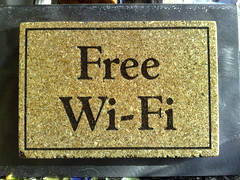 Everybody is used to free WiFi in coffee shops, airports and even restaurants, but perhaps less well known is the amount of WiFi in other public places, in particular retail stores. Our dashboard at Devicescape shows an increasing number of retail venues offering free WiFi.
Everybody is used to free WiFi in coffee shops, airports and even restaurants, but perhaps less well known is the amount of WiFi in other public places, in particular retail stores. Our dashboard at Devicescape shows an increasing number of retail venues offering free WiFi.
Topping the list of places you might not expect to find WiFi are The Home Depot and Sam’s Club, but there are entries in our reports almost every day from Macy’s, Nordstrom, Staples, Safeway, Whole Foods Markets, Winn Dixie and Kroger. And then there are the malls too, with the Macerich owned malls coming out as our clear winners in providing WiFi access to shoppers every day.
Users Want It
Our Q4 survey shows that over 80% of respondents would be more likely to visit a store if their device could automatically connect to free in-store WiFi.
In many retail locations cellular coverage is poor or non-existent, so being able to have that “always on” data connection hop automatically onto a WiFi network makes a lot of sense. Even if you can’t call or text because your carrier connection has gone, you can still email, IM, Skype etc over the store’s WiFi network.
In Store Applications
Aside from keeping your customers connected (which prevents them leaving the store prematurely just to update Facebook or check for email), there are plenty of other in-store applications that WiFi can enable.
Other than pulling up data sheets, comparing prices and reading product reviews, which are all great applications for in store WiFi (especially if you are confident of your pricing), think about other ways retailers can connect with their customers. Here’s a few ideas:
- A personal price scanner application (so you don’t need to hunt for the price scanner to check the price of the item you just picked up).
- Link to video tutorials, recipes or other related materials that a customer might find useful when using the product they’re looking at.
- Coupons & specials, specific to the location they’re in (since that can be determined from the WiFi network too).
- For restaurants or grocery stores, up to date health information about the food.
And I am sure there are more apps out there that can take advantage of in-store WiFi connections just waiting to be imagined and implemented.
Is It Safe?
There has been a lot of scaremongering in the press recently about how accessing your bank account or your email at a public hotspot could reveal your password to somebody else at the same location. This is nonsense. Banks all use SSL to provide end to end encryption (i.e. from your device to their servers). Nothing in between can see the unencrypted data, even if the WiFi link is unencrypted. Email services and even social networking sites like Facebook and Twitter also use SSL. A secure WiFi link at home makes a lot of sense (if you can, choose WPA2 and use a long passphrase – you won’t have to type it very often). But that’s because you want devices in your house to be able to talk to each other easily to stream media or copy files between them.
If you’re connecting to a public hotspot with your computer, you should make sure you’re running with a firewall enabled to stop anything coming in (although most hotspots these days prevent traffic flowing between devices connected at the same location). Your phone is inherently safer since it runs less services that allow remote connection, but if you are one of those power users who has installed something that does allow for incoming remote connections (e.g. ssh on a rooted handset), make sure you use good passwords! Of course, as a power user, you knew that already.
